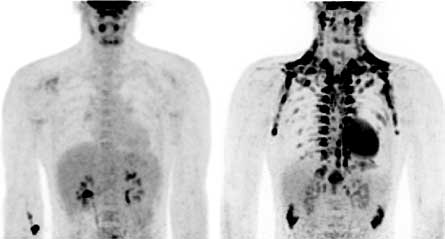The other, friendly fat
Brown fat is active in adult humans and could help keep them lean
- More than 2 years ago
In the ongoing battle of the bulge, maybe it is time to fight fat with fat.

Three new studies in the April 9 New England Journal of Medicine show that adult humans have brown fat, an energy-burning type of fat previously thought to be found only in animals and human babies.
White fat cells store energy in the form of lipids, but brown fat cells burn energy and give off heat. Mice and human babies have pads of brown fat on their backs that help maintain body temperature. Brown fat is activated by cold temperatures. Mice keep the fat throughout life, but brown fat disappears from babies’ backs and many researchers thought adult humans didn’t have brown fat. Or if they did, that it wasn’t important.
Now, the new studies demonstrate that brown fat is common in adults and may be important for regulating body weight and blood sugar. But the fat isn’t where people expected to find it. In adults, brown fat is found in the neck, above the collarbone, around the spine and in the abdomen.
Ronald Kahn of the Joslin Diabetes Center and Harvard Medical School in Boston and his colleagues examined records from 1,972 people who had PET-CT scans for other reasons. The researchers found evidence of brown fat in 7.5 percent of the women and 3.1 percent of the men. Brown fat was more apparent in people younger than 50, people with healthy blood sugar levels and in lean people. Comparisons with weather records showed the fat was more evident in scans taken when the weather was colder.
The researchers also examined tissue from people who had surgery for other reasons and found that the fat contained UCP1, a known marker of brown fat.
“It is now without dispute that brown fat is present in adult humans,” Kahn says.
More adults may have brown fat than found in the study because radiologists try to limit interference from the fat when taking scans. Autopsy studies may give a better picture of the prevalence of brown fat, says Francesco Celi, a clinical endocrinologist at the National Institute of Diabetes and Digestive and Kidney Diseases in Bethesda, Md.
“Generally speaking, people are not especially interested in looking at fat. It is a forgotten tissue,” Celi says. “Now things are becoming a lot more interesting.”
In another study, a team of researchers led by Wouter van Marken Lichtenbelt, a physiologist at the Maastricht University Medical Center in the Netherlands, scanned lean and overweight men at room temperature (22º Celsius or about 72º Fahrenheit) and 16ºC (about 61ºF). The researchers could see almost no brown fat in the room temperature scans, but the brown fat was readily apparent in lean men exposed to the cold. The more overweight the men in the study were, the less brown fat activity researchers detected.
In the third study, researchers led by Sven Enerbäck, a medical geneticist at the University of Göteborg in Sweden, scanned five people and found evidence of brown fat in all the volunteers. The researchers biopsied fat from three of the volunteers and found UCP1 and several other markers of brown fat.
Scientists suspect brown fat may help lean people keep weight off. Obese people may be overweight partly because they lack brown fat and can’t burn all the calories they take in, or the white fat they carry may provide insulation so brown fat isn’t necessary, van Marken Lichtenbelt says.
Whether missing brown fat is a cause or consequence of obesity, the answer “is a resounding we do not know,” Celi says.
Researchers may one day devise drugs or lifestyle changes that can keep brown fat burning, Celi says. But he cautions that the consequences of always-active brown fat aren’t known. The body may try to get more calories if brown fat burns too many, he says.







